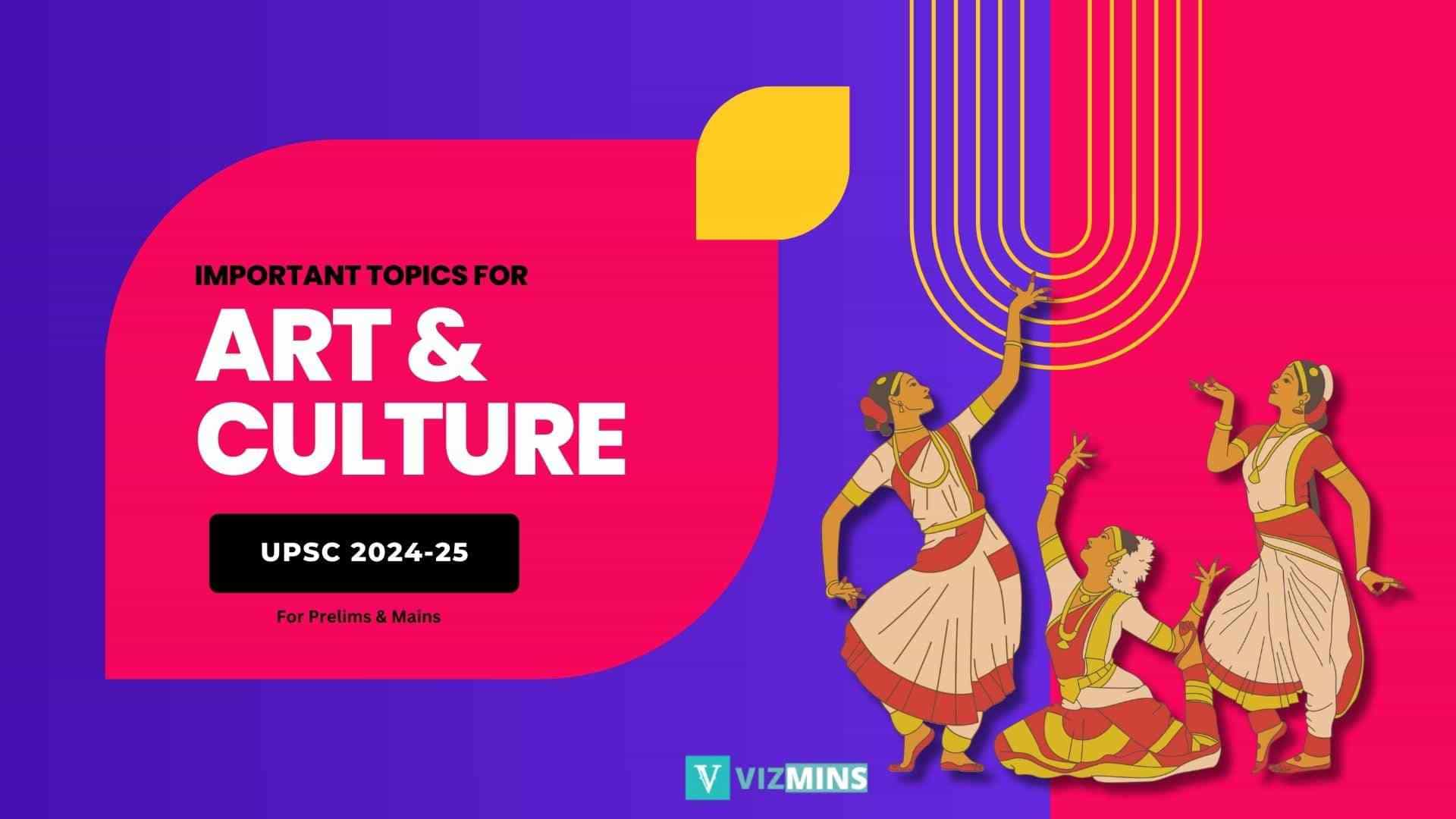Important Topics for Art and Culture For 2024-25
The “Important Topics for Art and Culture For 2024-25” course is designed for aspirants preparing for the UPSC Civil Services Examination and other state-level civil service exams. This course comprehensively covers General Studies Paper 1 (GS 1) – Art and Culture, integrating current affairs, significant concepts, key terminologies, and historical perspectives essential for success in the exam.
Overview
Art and Culture For 2024-25
The “Important Topics for Art and Culture For 2024-25” course is designed for aspirants preparing for the UPSC Civil Services Examination and other state-level civil service exams. This course comprehensively covers General Studies Paper 1 (GS 1) – Art and Culture, integrating current affairs, significant concepts, key terminologies, and historical perspectives essential for success in the exam.
Art and Culture is a crucial part of the UPSC Prelims and Mains syllabus, requiring an in-depth understanding of Indian heritage, classical and folk traditions, architecture, performing and visual arts, literature, and religious influences. However, given the vastness of the topic, aspirants often struggle with prioritizing relevant content. This course addresses that challenge by curating only the most important and exam-relevant topics in an easy-to-read notes format, followed by Prelims and Mains practice questions to enhance conceptual clarity and answer-writing skills.
What This Course Covers
1. Current Affairs Related to Art and Culture for 2024-25
- Recent discoveries and research in art, architecture, and heritage conservation.
- Government schemes and initiatives related to cultural preservation (e.g., ASI efforts, UNESCO Heritage updates, etc.).
- Cultural events and festivals celebrated at the national and international levels.
- Newly discovered inscriptions, manuscripts, or archaeological findings.
- Recent nominations and inclusions in UNESCO’s list of World Heritage Sites from India.
- Art and Culture in news—including awards, honors, and global recognitions of Indian cultural elements.
This section will ensure that aspirants stay updated with the latest developments in Art and Culture, a critical aspect of both Prelims and Mains.
2. Important Concepts and Terms Related to Art and Culture
To ensure that aspirants develop a strong foundation in the subject, this course includes concise yet comprehensive notes on:
- Indian Architecture – Evolution from ancient, medieval, and modern times, including temple architecture, rock-cut caves, Indo-Islamic structures, colonial architecture, and modern designs.
- Indian Paintings and Visual Arts – Traditional, folk, and modern art forms such as Madhubani, Warli, Pattachitra, Miniature Paintings, and contemporary movements.
- Performing Arts – Classical and folk dance forms, music traditions (Carnatic, Hindustani), theatre traditions, puppetry, and other performance-based art.
- Literature and Language – Classical and modern Indian literature, ancient scripts, important literary figures, and linguistic diversity.
- Religious and Philosophical Traditions – Influence of Hinduism, Buddhism, Jainism, Islam, Christianity, and other faiths on Indian culture.
- Cultural Influences of Foreign Invasions – Impact of Greeks, Kushanas, Mughals, British, and other rulers on Indian culture.
- UNESCO World Heritage Sites in India – Detailed analysis of India’s natural, cultural, and mixed heritage sites.
This section will strengthen conceptual understanding and provide clarity on frequently asked topics in the Art and Culture syllabus.
3. UPSC Prelims Practice Questions for Art and Culture For 2024-25
To help aspirants apply their knowledge effectively in an MCQ format, this course includes a set of practice questions based on the topics covered. The Prelims questions are designed to:
- Cover static concepts as well as current affairs-based questions.
- Familiarize aspirants with UPSC’s pattern of asking tricky factual questions.
- Test understanding through elimination techniques and conceptual clarity.
- Include explanations for each answer to reinforce learning.
Sample Question:
Which of the following pairs is correctly matched?
- Madhubani Painting – Rajasthan
- Kathakali – Kerala
- Monolithic Kailasa Temple – Chola Dynasty
Select the correct answer using the code given below:
(a) 1 and 2 only
(b) 2 only
(c) 1 and 3 only
(d) 2 and 3 only
✅ Answer: (b) 2 only
Explanation:
- Madhubani painting is a traditional art form of Bihar, not Rajasthan.
- Kathakali is a dance form originating from Kerala.
- The Kailasa Temple at Ellora was built by the Rashtrakutas, not the Chola dynasty.
4. UPSC Mains Practice Questions for Art and Culture For 2024-25
To help aspirants prepare for Mains answer writing, this course includes model Mains questions along with approach guidelines. These questions cover:
- Analytical and conceptual understanding of Art and Culture topics.
- Interdisciplinary approach, linking culture with history, polity, and economy.
- Current relevance, focusing on government initiatives, global recognitions, and contemporary debates on heritage conservation.
Sample Question:
“India’s diverse art and culture is a reflection of its historical evolution and socio-religious traditions.” Discuss with examples. (250 words, 15 marks)
Approach:
- Introduction – Define Indian art and culture, highlighting its historical continuity.
- Body
- Evolution through ancient, medieval, and modern times.
- Influence of religion, foreign invasions, and colonial rule.
- Examples of architecture, paintings, dance, and literature.
- Role of government in cultural preservation.
- Conclusion – Summarize India’s rich cultural legacy and the need for conservation.
By practicing such exam-oriented questions, aspirants will develop the writing skills necessary to score well in Mains.
Why This Course ( Art and Culture For 2024-25) is Essential for UPSC Aspirants?
✅ Comprehensive Coverage – Covers both static and current affairs-based Art and Culture topics.
✅ Simplified Notes Format – Easy to revise and retain important facts.
✅ UPSC-Patterned Practice Questions – Covers both Prelims and Mains formats.
✅ Concept-Based Learning – Ensures better recall and deeper understanding.
✅ Updated for 2024-25 – Includes latest trends and developments in Art and Culture.
Conclusion
Art and Culture is often perceived as a difficult and vast subject, but with the right strategy and concise notes, aspirants can master it effectively. This course provides structured, exam-relevant content that will enhance your chances of scoring high in UPSC Prelims and Mains.
Join the course today and take a step closer to your UPSC success! 🚀




